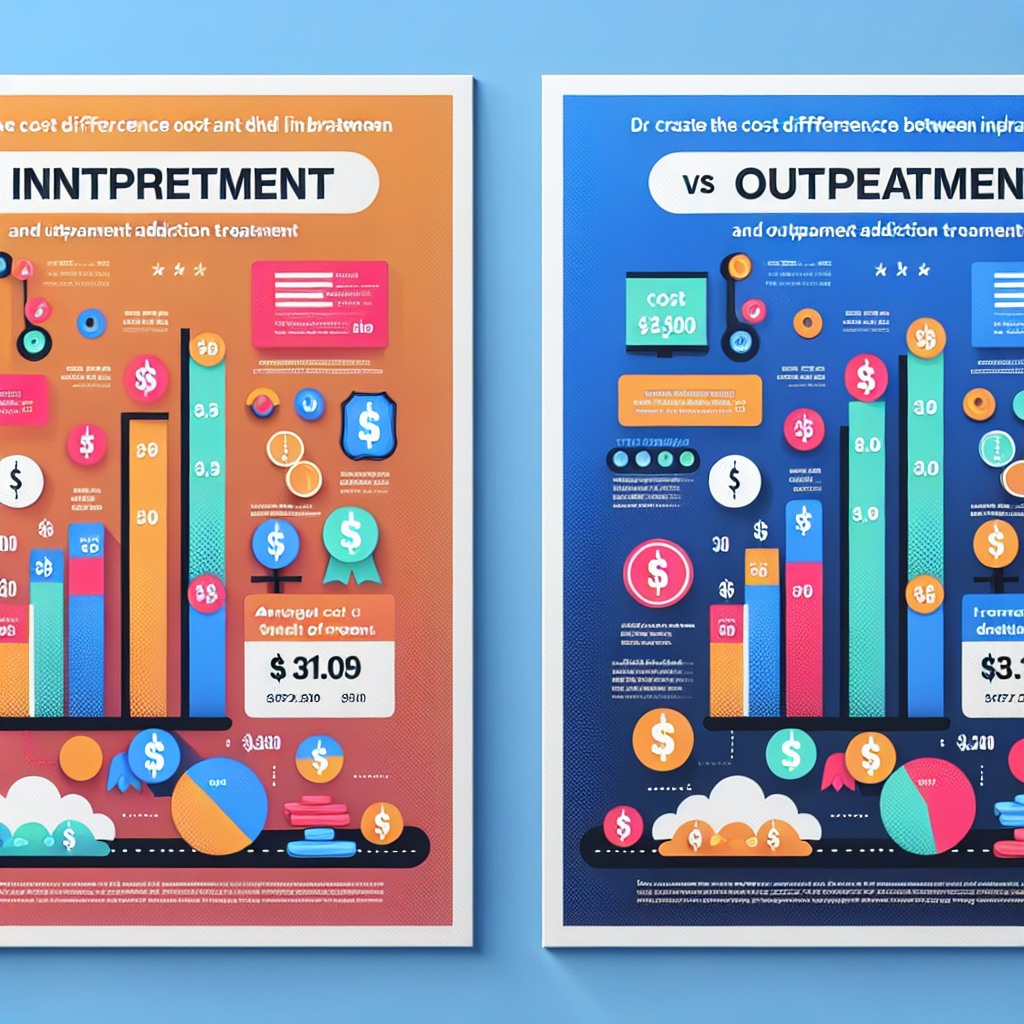-
Table of Contents

“Outpatient addiction treatment: Affordable care without the hospital stay.”
Introduction
Inpatient and outpatient addiction treatment programs differ significantly in terms of costs, primarily due to the varying levels of care and resources required. Inpatient treatment, also known as residential treatment, typically involves a higher financial commitment as it includes 24-hour medical supervision, accommodation, meals, and intensive therapeutic services. These programs often range from several thousand to tens of thousands of dollars for a 30-day stay, depending on the facility and the specific services provided. On the other hand, outpatient treatment is generally more affordable, as it allows individuals to live at home while attending scheduled therapy sessions and medical appointments. The costs for outpatient programs can vary widely but are usually lower than inpatient care, making it a more accessible option for many individuals. However, the choice between inpatient and outpatient treatment should be based on the severity of the addiction, the individual’s personal circumstances, and the level of support needed for successful recovery.
Comparing Costs: Inpatient vs. Outpatient Addiction Treatment
When considering addiction treatment, one of the most significant factors to weigh is the cost. The financial burden of treatment can be a major concern for individuals and families seeking help. Understanding the differences in costs between inpatient and outpatient addiction treatment can provide clarity and help in making an informed decision. Both treatment options have their unique advantages and financial implications, and it is essential to explore these aspects to determine the best path to recovery.
Inpatient addiction treatment, often referred to as residential treatment, involves staying at a facility for an extended period, typically ranging from 28 days to several months. This immersive approach provides a structured environment where individuals can focus entirely on their recovery without the distractions and triggers of everyday life. The comprehensive nature of inpatient treatment includes 24-hour medical supervision, individual and group therapy sessions, and various therapeutic activities. However, this level of care comes at a higher cost. The expenses associated with inpatient treatment can range from $6,000 to $20,000 for a 30-day program, with some luxury facilities charging even more. These costs cover accommodation, meals, medical care, and therapeutic services, making it a substantial investment in one’s health and future.
On the other hand, outpatient addiction treatment offers a more flexible and cost-effective alternative. Outpatient programs allow individuals to live at home and continue with their daily responsibilities while attending scheduled treatment sessions. This approach is particularly beneficial for those with strong support systems and less severe addiction issues. The cost of outpatient treatment is significantly lower than inpatient care, typically ranging from $1,000 to $5,000 for a three-month program. This affordability makes outpatient treatment an attractive option for many, especially those who cannot afford the high costs of residential care. Additionally, outpatient programs often provide similar therapeutic services, such as individual and group therapy, but without the added expenses of accommodation and round-the-clock supervision.
While the cost differences between inpatient and outpatient treatment are evident, it is crucial to consider the value each option provides. Inpatient treatment offers a higher level of care and a more controlled environment, which can be vital for individuals with severe addiction or co-occurring mental health disorders. The intensive nature of inpatient programs can lead to higher success rates and a more robust foundation for long-term recovery. Conversely, outpatient treatment allows individuals to maintain their daily routines and responsibilities, which can be empowering and conducive to recovery for those with milder addiction issues. The lower cost of outpatient care also means that individuals can access treatment for a more extended period, potentially leading to better outcomes over time.
Ultimately, the decision between inpatient and outpatient addiction treatment should be based on individual needs, the severity of the addiction, and financial considerations. It is essential to consult with healthcare professionals and addiction specialists to determine the most appropriate level of care. While the costs of treatment can be daunting, it is important to remember that investing in recovery is an investment in a healthier, more fulfilling future. By carefully weighing the options and considering both the financial and therapeutic aspects, individuals and families can make informed decisions that pave the way for lasting recovery and a brighter tomorrow.
Financial Implications of Inpatient and Outpatient Addiction Treatment
When considering addiction treatment, one of the most significant factors to weigh is the financial implications of inpatient versus outpatient care. Understanding the cost differences between these two options can help individuals and families make informed decisions that align with their financial situations and treatment needs. While both inpatient and outpatient treatments aim to provide comprehensive care and support for those struggling with addiction, the financial burden they impose can vary significantly.
Inpatient addiction treatment, often referred to as residential treatment, involves a patient staying at a facility for an extended period, typically ranging from 28 days to several months. This type of treatment provides a structured environment where individuals can focus solely on their recovery without the distractions and triggers of everyday life. However, the intensive nature of inpatient care comes with a higher price tag. The costs associated with inpatient treatment can range from $6,000 to $20,000 for a 30-day program, depending on the facility’s location, amenities, and level of care provided. High-end facilities with luxury accommodations and specialized services can charge even more, sometimes exceeding $50,000 for a month-long stay.
On the other hand, outpatient addiction treatment allows individuals to live at home while attending scheduled therapy sessions and support groups. This flexibility enables patients to maintain their daily responsibilities, such as work or school, while receiving treatment. Outpatient programs vary in intensity, with some requiring daily attendance and others meeting a few times a week. The cost of outpatient treatment is generally lower than inpatient care, ranging from $1,000 to $10,000 for a three-month program. The reduced cost is primarily due to the absence of room and board expenses, making outpatient treatment a more affordable option for many individuals.
Despite the apparent cost differences, it is essential to consider the long-term financial implications of both treatment options. Inpatient treatment, while more expensive upfront, often provides a higher level of care and support, which can lead to more successful outcomes and a lower likelihood of relapse. This can ultimately result in fewer expenses related to repeated treatment or ongoing medical care. Conversely, outpatient treatment, though more affordable initially, may not provide the same level of support and structure, potentially leading to a higher risk of relapse and additional costs down the line.
Insurance coverage is another critical factor to consider when evaluating the financial implications of addiction treatment. Many insurance plans cover a portion of both inpatient and outpatient treatment costs, but the extent of coverage can vary widely. It is crucial to review your insurance policy and speak with a representative to understand what is covered and what out-of-pocket expenses you may incur. Additionally, some treatment facilities offer sliding scale fees or payment plans to help make treatment more accessible for those with limited financial resources.
Ultimately, the decision between inpatient and outpatient addiction treatment should be based on a comprehensive evaluation of an individual’s specific needs, the severity of their addiction, and their financial situation. While cost is an important consideration, it should not be the sole determining factor. The goal is to choose a treatment option that provides the best chance for long-term recovery and improved quality of life. By carefully weighing the financial implications and exploring all available resources, individuals and families can make informed decisions that support lasting recovery and financial stability.
Q&A
1. **Question:** How do the costs of inpatient addiction treatment compare to outpatient addiction treatment?
**Answer:** Inpatient addiction treatment is generally more expensive than outpatient treatment due to the costs associated with housing, meals, and 24-hour medical care.
2. **Question:** What factors contribute to the higher costs of inpatient addiction treatment?
**Answer:** The higher costs of inpatient addiction treatment are primarily due to the need for residential facilities, round-the-clock medical supervision, and comprehensive support services.
Conclusion
Inpatient addiction treatment generally incurs higher costs compared to outpatient treatment. This is due to the comprehensive nature of inpatient care, which includes 24-hour medical supervision, accommodation, meals, and intensive therapy sessions. Outpatient treatment, on the other hand, is less expensive as it allows individuals to live at home and attend scheduled treatment sessions, thereby reducing costs associated with housing and round-the-clock care. However, the choice between inpatient and outpatient treatment should be based on the severity of the addiction and the specific needs of the individual, rather than cost alone.



